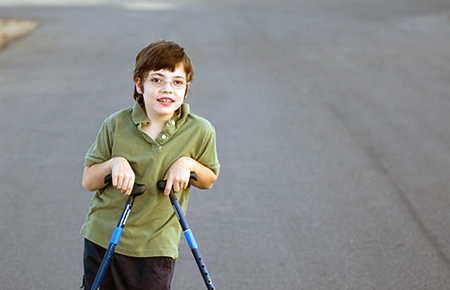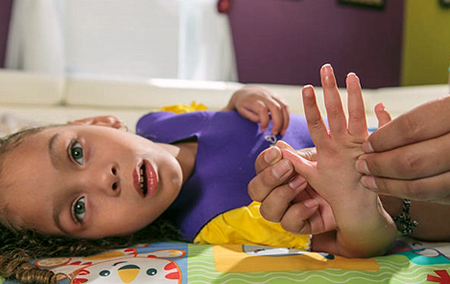What is spasticity and paresis?


Spasticity is a motor disorder that is manifested in an abnormally enhanced reflex response, increased muscle tone up to cramps, to muscle stretching. It manifests in exaggerated tendon reflexes, intence muscle tone and resistance to passive movements. It is commonly accompanied by severe pain in the major muscle groups.
Paresis it is a decrease in muscle strength with a limitation of the range of voluntary movements.
Spastic paresis, is the main reason for the disability of neurological patients, since it develops in most diseases and injuries of the central nervous system. While the movements of the patient are limited primarily by the paresis, the pronounced spasticity significantly worsens the movement disorders even more restricting the patient's capabilities.
Once it occurs, the disorder most of the time persists for a lifetime. This complex of symptoms is the main symptom of the upper motor neuron syndrome (UMNS). It is the motor control changes that can occur in skeletal muscle after the damage of UMNS. This syndrome includes two groups of phenomena: positive and negative.
Negative signs of UMNS include weakness, loss of dexterity, and fatigue. This complex of symptoms causes a drop in the patient's motor activity and, in essence, is the main manifestation of paresis - the main symptom of UMNS. Negative phenomena, unfortunately, cannot be helped with any rehabilitation methods.
The positive phenomena of UMNS can also cause disability, but they respond to some extent to treatment. These signs include: spasticity, tendon hyperreflexia with expansion of the reflexogenic zone, clonus (clonic seizures), spasms, dystonia and contractures, dyssynergia.
Short information about spasticity and paresis
Causes of spastic paresis
The syndromes are characteristic manifestation of neurological diseases such as:
- Cerebral palsy (CP);
- Various lesions of the spinal cord;
- Brain damage from trauma, stroke and other illnesses.
CP is the most frequent cause of childhood neurological disability.
Muscle spasticity is quite a frequent problem. It occurs in 60 - 75% of people with CP. It can affect all limbs, three limbs, two limbs on one side of the body, or one limb (usually, an arm).
Manifestations of spastic paresis in different diseases

The clinical manifestations of spastic paresis depend not only on the level of lesion of the descending motor pathways (spinal or cerebral), but also on the nature of their pathology. This symptom complex can be a consequence of both an rupture of the fibers of the motor systems (brain trauma, stroke) or their compression (tumors), and the result of a demyelinating process, i.e. a disease causing damage to the protective covering that surrounds nerve fibers (remitting multiple sclerosis), axonal degeneration (conserved process that can be activated by different stimuli) (Strumpel's familial paraplegia, and others) and the effect of the last two processes combined (primary and secondary progressive multiple sclerosis).
Demyelinating and axonal lesions of the descending motor systems differ in the clinical features of paresis and response to treatment. So, in multiple sclerosis, there is a huge diifference of the severity of individual symptoms among patients and usually a good effect of pathogenetic therapy (corticosteroids, plasmapheresis). In addition, in this disease there is a clear dependence of the severity of spasticity on the patient's position. The studies show that when lying down, spasticity is often not sharply expressed, while when walking, it increases significantly.
In degenerative diseases, there is a steady progression of the disease and, accordingly, an aggravation of spastic paresis from the very onset of the disease. Moreover, in patients with, for instance, amyotrophic lateral sclerosis, the main symptom is a decrease in muscle strength. And for familial spastic paraplegia, muscle hypertension prevails over the severity of paresis, and therefore these patients retain the ability to move even at the later stages of the pathological process. These differences, apparently, are due to the damage of different types of fibers of the pyramidal tract, since in the first case, the destructive process is localized mainly in thick, phasic fibers, in the second - in thin, tonic fibers.
Soft tissue changes and contractures due spasticity and spastic paresis

Contractures are limitation of passive movements in the joint, ligaments, and muscles. It is a condition in which the limb cannot be fully bent or unbent in one or more joints, caused by scarring of the skin, tendons, muscle and joint diseases, pain reflex and other reasons.
Limitation of range of motion in central motor disorders is not always a simple consequence of paresis and muscle hypertension. In such patients, changes may develop in the soft tissues of the affected limbs, including tendons, ligaments, and joints, which leads to a decrease in their flexibility. It is obvious that contractures due to changes in soft tissues are the result of prolonged stay in a contracted position of spastic muscles.
However, changes in soft tissues are not always caused by spastic hypertension; they may also have a more independent significance in the formation of the phenomenon of spastic gait. It allows suggesting that in some cases the so-called spastic gait may occur, most likely due to changes in the rheology (internal properties) of the muscle itself, rather than due to an increase in the stretch reflex.
To prevent it, it is important to emphasize the good condition of those spastic muscles that have been fully stretched for a long time each day. It is recommended to fully stretch these muscles for 2 hours every 24 hours.
Thus, muscle hypertension associated with impaired muscle features often has a neural component (secondary to spasticity) and a biomechanical component (secondary to soft tissue changes). It is obvious that biomechanical hypertension does not depend on the rate of muscle stretching and limits movement even at slow speeds. Moreover, biomechanical hypertension does not respond to antispastic substances and can be helped with physiotherapy, stretching of the paretic limb, comfortable position, orthoses and physical manipulations. In some cases, surgery may be necessary to remove obstructions and prevent soft tissue contractures. In practice, a mixed form of neural and biomechanical hypertension is more common and it is very difficult to clinically distinguish the contribution of each component. Actively interfering with spasticity (anti-spastic drugs or topical botulinum toxin injections) can alleviate at least the neural component of hypertension. This effect is achieved even with fixed contractures in the limbs.
Long-term spasticity causes changes in soft tissues that most disabling the patient and resistant to treatment are recorded especially often. Increasing limb deformity often leads to rapidly diminishing function, resulting in problems with hygiene, laying, moving and eating, which leads to a high predisposition to various complications.
Urinary disorders
Urination disorders significantly affect the condition of patients with lower spastic paraparesis. There is a connection between urinary retention and the intensity of spasticity, since the latter is sharply increased with acute or prolonged inability to urinate. A similar picture in such patients can develop with an acute infection of the bladder. Due to the fact that the risk of developing a urological infection is more often associated with urinary retention, timely catheterization of the bladder in these individuals is important. It is advised to train a patient to perform this manipulation on their own.
Speech and swallowing disorders

The damage to the upper motor neuron usually manifests in spasticity in the arms and legs. The spasticity of the muscles involved in speech and swallowing is less often, but can be observed and create more problems for the patient. In this case, difficulties arise in the process of eating (dysphagia) and communicating (dysarthria). Due to swallowing disorder, there is a risk of aspiration with the subsequent development of pneumonia. These patients find it easier to swallow and talk when upright and sitting.
Pain
This symptom is not common in patients with spastic paresis. At the same time, with significantly pronounced muscle hypertension, patients often complain of nagging pain in the legs. However, pain can be acute if flexion and extension spasms are present. In this case, it becomes necessary to periodically use analgesics and muscle relaxers such as Tiazidine. Prolonged improper placement of a paralyzed limb can also cause pain due to concomitant changes in muscles and joints. Besides, not only neurogenic and local processes can cause pain, but also periodic stimuli of any nature. For example, an ingrown nail or tissue damage caused by compression can cause a deepening of muscle hypertension and trigger a vicious circle that aggravates pain and further aggravates spasticity.
Treatment and rehabilitation
Treating muscle spasticity has 4 main goals:
- Bettering of muscle function;
- Facilitating patient self-care;
- Delaying or preventing the development of muscle tension (contractures);
- Reducing or getting rid of pain.
Spasticity treatment methods depend on the severity of symptoms and muscle groups involved in the pathological process:
- Medication therapy. The most frequently used medicines are muscle relaxants such as Mydocalm, Tiazidine, and others. For more severe spasticity, Baclofen is prescribed. Unfortunately, even the timely started and regularly conducted treatment in cerebral palsy is not a warranty of a sustainable result. Moreover, a number of common negative effects of systemic muscle relaxants restrict their long-term use, especially in pediatric practice.
- Neuromuscular blockade. It is carried out by injecting botulinum toxin (Botox) or Dysport into the muscles with the most pronounced spasticity. The relaxation effect develops after a few days and lasts up to a month.

- Functional therapies used along with medicines include physiotherapy, massage and exercise therapy, as well as orthoses and technical rehabilitation aids for functional positioning of the limb, stabilization and maintenance of verticalization of the trunk. It helps prevent the development of contractures (stiff muscles, joints, ligaments, etc.), improve motor functions and increase recovery potential.
- Orthopedic surgeries that improve muscle function. This includes treatments such as selective dorsal rhizotomy, neurotomy, and baclofen pump implantation. Such a modern method of treatment is indicated for spastic diplegia, paraplegia and tetraplegia of any severity in children over 3 years of age in the lack of severe symptoms and with preserved intellect, motivated to conduct physiotherapy. The principle lies in the incomplete intersection of the posterior sensory roots or their individual fascicules to "turn off" those neurons that have lost the inhibitory effects from the cerebral cortex under electroneuromyographic control. With the right selection of patients after selective dorsal rhizotomy, good and excellent results of the operation can be expected in 80% of cases.
- Neurotomy is used for severe spasticity in the legs to facilitate patient care, without curing the spasticity as such, but relieves muscle tension. The principle is to partially cross the fibers of the peripheral nerve, which leads to a decrease in muscle tone.
Baclofen pumps are used in patients with severe tetraplegia (three limbs are affected) and diplegia (two limbs are affected). The principle consists in the dosed introduction of Baclofen into the cerebrospinal fluid. It can replace oral administration of Baclofen, and reduce its side effects, since when it is introduced into the cerebrospinal fluid, a lower dosage is required for a therapeutic effect. This system consists of a reservoir containing Baclofen or a similar drug, a pump (pump), with the help of which the drug is dosed into the intrathecal space of the spinal cord through a lumbar catheter and a power unit (service life - 5-7 years). The pump itself is a round metal disc 2-3 cm thick and about 7 cm in diameter. The pump is implanted under the skin in the abdomen and then programmed using the remote control. It differs from other methods of treatment by a higher risk of infection.
Post by: Jacob Hansen, General healthcare practitioner, National health centre, Stavanger, Norway
(Updated at Apr 14 / 2024)

